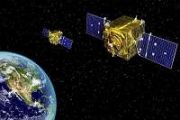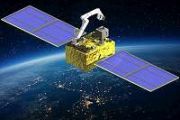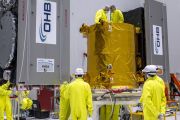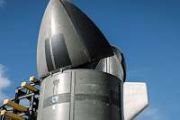
Copernical Team
Satcom Direct plane simple antenna system takes off
 Satcom Direct, the business aviation solutions provider, is celebrating Federal Aviation Association, (FAA) approval of Supplemental Type Certificates, (STCs) for the Satcom Direct Plane Simple Ku-band tail-mounted Antenna System. Following a multi-model, (AML) STC approval, Gulfstream G550, G450, GV and GIV types can now be equipped with the advanced technology terminal.
The Satcom Direct
Satcom Direct, the business aviation solutions provider, is celebrating Federal Aviation Association, (FAA) approval of Supplemental Type Certificates, (STCs) for the Satcom Direct Plane Simple Ku-band tail-mounted Antenna System. Following a multi-model, (AML) STC approval, Gulfstream G550, G450, GV and GIV types can now be equipped with the advanced technology terminal.
The Satcom Direct The Milky Way's inner ring
 Using a combination of observed stars and a realistic model of the Milky Way, scientists at the Max Planck Institute for Extraterrestrial Physics have found a new structure in our home galaxy. Just outside the Galactic bar, they found an inner ring of metal rich stars, which are younger than the stars in the bar. The ages of the ring stars can be used to estimate that the bar must have formed
Using a combination of observed stars and a realistic model of the Milky Way, scientists at the Max Planck Institute for Extraterrestrial Physics have found a new structure in our home galaxy. Just outside the Galactic bar, they found an inner ring of metal rich stars, which are younger than the stars in the bar. The ages of the ring stars can be used to estimate that the bar must have formed SOFIA maps the first magnetic fields of a galactic bone in their entirety
 The Stratospheric Observatory for Infrared Astronomy (SOFIA) -a joint project of NASA and the German Space Agency at DLR-mapped the very first and most detailed map of the long filaments that outline the densest part of a galaxy's arms (galactic bones). It is the most detailed map of the magnetic fields of G47-a giant filamentary bone in the Milky Way. The results were published in The Astrophys
The Stratospheric Observatory for Infrared Astronomy (SOFIA) -a joint project of NASA and the German Space Agency at DLR-mapped the very first and most detailed map of the long filaments that outline the densest part of a galaxy's arms (galactic bones). It is the most detailed map of the magnetic fields of G47-a giant filamentary bone in the Milky Way. The results were published in The Astrophys Webb's mid-infrared instrument cooldown continues
 "The Mid-Infrared Instrument (MIRI) and other Webb instruments have been cooling by radiating their thermal energy into the dark of space for the bulk of the last three months. The near-infrared instruments will operate at about 34 to 39 kelvins, cooling passively. But MIRI's detectors will need to get a lot colder still, to be able to detect longer wavelength photons. This is where the MIRI cry
"The Mid-Infrared Instrument (MIRI) and other Webb instruments have been cooling by radiating their thermal energy into the dark of space for the bulk of the last three months. The near-infrared instruments will operate at about 34 to 39 kelvins, cooling passively. But MIRI's detectors will need to get a lot colder still, to be able to detect longer wavelength photons. This is where the MIRI cry How likely is the multiverse model a reality
 In fiction and in films such as Spiderman: Into the Spider-Verse, parallel universes - also called the multiverse - exist alongside our own, with anything from small differences in events to entirely different rules of physics. It is an exciting and fascinating idea. Physicists have given the question of whether parallel universes could exist a lot of thought - and have come up with quite a few
In fiction and in films such as Spiderman: Into the Spider-Verse, parallel universes - also called the multiverse - exist alongside our own, with anything from small differences in events to entirely different rules of physics. It is an exciting and fascinating idea. Physicists have given the question of whether parallel universes could exist a lot of thought - and have come up with quite a few Hubble probes extreme weather on ultra-hot Jovian exoplanets
 In studying a unique class of ultra-hot exoplanets, NASA Hubble Space Telescope astronomers may be in the mood for dancing to the Calypso party song "Hot, Hot, Hot." That's because these bloated Jupiter-sized worlds are so precariously close to their parent star they are being roasted at seething temperatures above 3,000 degrees Fahrenheit. That's hot enough to vaporize most metals, including ti
In studying a unique class of ultra-hot exoplanets, NASA Hubble Space Telescope astronomers may be in the mood for dancing to the Calypso party song "Hot, Hot, Hot." That's because these bloated Jupiter-sized worlds are so precariously close to their parent star they are being roasted at seething temperatures above 3,000 degrees Fahrenheit. That's hot enough to vaporize most metals, including ti Citizen scientists help map ridge networks on Mars
 Over the last two decades, scientists have discovered unusual ridge networks on Mars using images from spacecraft orbiting the Red Planet. How and why the ridges formed and what clues they may provide about the history of Mars has remained unknown.
A team of scientists, led by Aditya Khuller of Arizona State University's School of Earth and Space Exploration and Laura Kerber of NASA's Jet
Over the last two decades, scientists have discovered unusual ridge networks on Mars using images from spacecraft orbiting the Red Planet. How and why the ridges formed and what clues they may provide about the history of Mars has remained unknown.
A team of scientists, led by Aditya Khuller of Arizona State University's School of Earth and Space Exploration and Laura Kerber of NASA's Jet Sol 3436: Motion Accomplished
 There was good news when we came in for planning today - our remote mast recovery and all our other activities completed successfully, including the drive.
Today I took on the role of "Supratactical Uplink Lead," and in that role I primarily worked to sketch out what our upcoming plans will look like. I was able to plan for new activities now that we successfully drove away from our prior
There was good news when we came in for planning today - our remote mast recovery and all our other activities completed successfully, including the drive.
Today I took on the role of "Supratactical Uplink Lead," and in that role I primarily worked to sketch out what our upcoming plans will look like. I was able to plan for new activities now that we successfully drove away from our prior Arctic simulation of Moon-like habitat shows wellbeing sessions keep you sane
 Researchers at the University of Surrey and the University of Milano-Bicocca have partnered with SAGA Space Architects to investigate the psychological impact of social isolation in harsh environments, such as on the Moon. This research formed part of the LUNARK project which explored how humans could survive on the Moon and have successful habitats there in the future.
The LUNARK project
Researchers at the University of Surrey and the University of Milano-Bicocca have partnered with SAGA Space Architects to investigate the psychological impact of social isolation in harsh environments, such as on the Moon. This research formed part of the LUNARK project which explored how humans could survive on the Moon and have successful habitats there in the future.
The LUNARK project SpaceX completes static fire test ahead of first private astronaut mission to ISS
 SpaceX on Wednesday completed a static fire test ahead of its launch of the first-ever private mission to the International Space Station, Axiom-1.
The mission, dubbed Axiom-1, will see a crew of four citizens strap into a Crew Dragon capsule and blast off on a 10-day flight where they will conduct a number of research investigation onboard the orbital outpost.
The launch, schedu
SpaceX on Wednesday completed a static fire test ahead of its launch of the first-ever private mission to the International Space Station, Axiom-1.
The mission, dubbed Axiom-1, will see a crew of four citizens strap into a Crew Dragon capsule and blast off on a 10-day flight where they will conduct a number of research investigation onboard the orbital outpost.
The launch, schedu 































